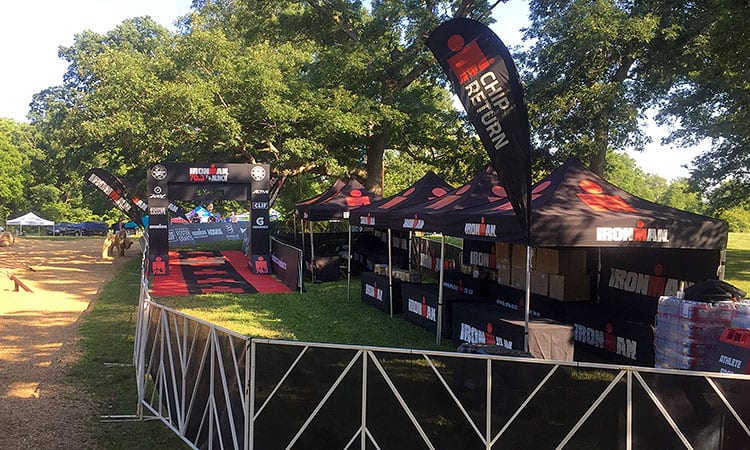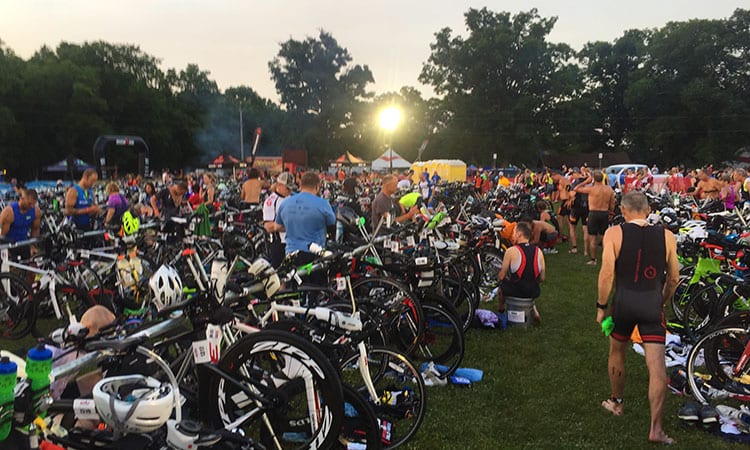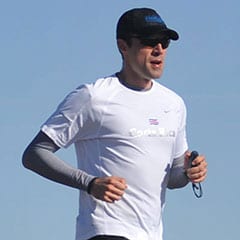
Chicago resident Dan Solera is a long-time runner and finisher of nearly 120 races, including 45 half marathons, 37 marathons and four ultramarathons in 47 states and three countries. Dan recently decided to switch gears and take the plunge (literally), completing his first triathlon at last month’s IRONMAN 70.3 in Muncie, Indiana. So we asked him to share his lessons learned, to help other first-time triathletes know how to prepare and what to expect. And we’d love for you to share your own “tri”ed-and-true advice in the Comments below!
I was completely beat as I crossed the finish line of my first triathlon in Muncie, Indiana. Both my quads had cramped, and my calves were in danger of following suit. I would have stopped to walk were it not for the announcer loudly belting my name to the crowds of spectators and athletes who had already earned their hardware, as if taunting me to give into the pain.
It was a very warm day, with water temperature in the low 80s and the mercury rising to 88°F as I began the run. But despite my muscular issues towards the end of the race, I was happy with the result. I made it to the finish without choking on water, crashing on the bike, or suffering serious injury on the run. For my first go-round on the multidisciplinary circuit, I was quite thrilled.
Could I have done things differently and improved my result? Absolutely. Here are five crucial lessons I learned from my first attempt at the triathlon, and what I could do in the future to either improve my time or make it to the finish line in better shape.
Have someone in your corner
My development from spectator to runner was thanks to encouragement from my father-in-law, Steve. It was also due to his maniacal plans that I became a cyclist last year, so it was only natural that in 2018 I would add a third line to my endurance resume. He has been doing triathlons since before wicking fabrics were a thing, so there were many lessons I was lucky to learn the easy way. For example:
- Put a plastic bag over your foot before putting on a wet suit, and your foot will slide right through.
- Bring old water bottles that you don’t mind losing, because at the bike aid stations, you’ll likely toss them and simply get new ones.
- Taking an extra two minutes in transition to make sure you are put together and haven’t forgotten anything won’t kill you.
The fact that this race came with a multi-page booklet of just rules was a surprise. I assumed basic civility and common etiquette would suffice. It was intimidating at first to have to internalize the penalties for drafting, understand which fabrics were forbidden, and keep track of the temperature thresholds for wetsuits. There’s also a laundry list of offenses that can disqualify you. With a veteran triathlete to answer my questions with real-world experience, preparation once again became a fun personal challenge and not a meticulous test. That said…

Know the rules
There aren’t many ways to screw up a footrace. You can blatantly cheat and cut the course, or you can go for broke and wear in-line skates and hope nobody notices your speedy glide. For the 99% of us with a robust moral compass, we know to run forward, and try — as much as possible — to give every athlete enough space to run their own race. Every manner of clothing or accessory is allowed, from head-to-toe Sesame Street costumes to prototype track shoes.
Not in a triathlon. As mentioned above, there are specific fabrics that aren’t allowed in the water above certain temperatures, there’s a minimum distance allowed between riders unless one is attempting to pass, and between wristbands, bibs, and ankle bracelets, there are many, many ways to get in trouble. Prior to hearing the starter’s pistol, make sure to understand and map out every item you need for each phase of the race. If you’re like me and you’ve run over 100 races, you might have to consciously override the blasé confidence that comes with experience.
Don’t train like it’s a footrace
When training for a marathon (26.2 miles), most training programs rarely have you running past 20 miles. Someone attempting their first 10K (6.2 miles) might only run up to five miles in preparation for the full distance on race day. The idea behind this philosophy involves adrenaline, nutrition, and the body’s remarkable ability to do amazing things when tested.
With a triathlon, however, I learned the hard way that this philosophy does not apply, and if it does, then I executed it poorly. Because if you’re expected to run 13.1 miles after a 1.2-mile swim and a 56-mile bike ride, then you should be comfortable just running much farther during training. I made the mistake of applying this philosophy to each individual discipline. I strung together short swims with short rides, then medium rides with medium runs, and lastly semi-long rides with medium runs.
With the exception of the swim, I never finished the triathlon distance in either the bike or run individually while training. This might seem like an obvious mistake, but with my 10-year background in running, it was tough to teach this old dog new tricks. Next time, I will likely push my long runs to 16 and even 20 miles. The same applies to the bike. My gradual increase in mileage topped out at around 45 miles. In the future, I will ride up to 80 miles so that 56 won’t feel like an epic gut.

Ingest more protein, earlier
As a runner, neither swimming nor biking really get my heart rate up. My mantra throughout most of the event was get to the run, to put my helmet down and lace up in one piece, ready to tackle inarguably the toughest of the three races. However, the problem with this mantra is that it doesn’t treat the first two with the respect they deserve.
I wasn’t coasting, by any stretch of the imagination. But I got through them with only water and Gatorade, and by the time the run started, I knew I was going to pay the price. I might not have felt it during either of the first two races, but I had put a beating on my legs that would haunt me in the run. Had I added a protein-based element to my race-day nutrition, like Perpetuem from Hammer Nutrition or protein bars, I might have avoided the serious strain my quads suffered halfway through the run.
Do a tune-up
I decided, not entirely out of arrogance, that my first triathlon would be in the Half Ironman (70.3) distance. The Olympic distance just seemed too easy to complete, as if my running experience alone would allow me to reach the finish (albeit not in elegant fashion). As I dragged myself across the finish line in Muncie, I was humbled, or rather, beaten, into the realization that I was wrong. Not many of us run a half marathon as our first footrace. We start with a 5K, then move up.
In retrospect, I should have tried a shorter tri first to iron out the kinks and get a sense of the true challenge and its many moving parts and learn many valuable lessons along the way. It would have given me a sense of how long my transition times should be and which foods and accessories I should prioritize. It would have also given me a better idea of what it’s like to get prodded, poked, and jabbed repeatedly during the swim. Even though I managed to get into Lake Michigan three times to practice swimming in open water, I never had to contend with many hands flailing around me, splashing water, and sometimes making contact. Lastly, it would have given me a taste of what my legs would face in the run.
I have the benefit that my first tri was a hot one, all but guaranteeing that, even if I duplicate my suboptimal training for the next one, I will likely notch a better finish time. You know the saying, “If at first you succeed but only by the skin of your teeth, repeat your efforts and hope for the best?” Or I could up the ante and push myself in each component beyond its individual race distance, improve my race-day nutrition, and take a stab at a Sprint or Olympic event to truly become one with the sport.
After all, I didn’t buy all this crap to do it just once.
About our guest contributor:
 Dan Solera was bitten by the running bug in 2009 and hasn’t looked back. At any given point he is training for his next big race, which will likely contribute to his goal of running a marathon in all 50 states. His love of running is matched only by his predilection for heavy metal, skiing and writing, interests which seldom intersect. His dream is to take a three-month summer sabbatical and travel through Europe, running races in every major city until his medal rack is flush with mementos from the Old World. Follow along with his marathon musings at dans-marathon.com.
Dan Solera was bitten by the running bug in 2009 and hasn’t looked back. At any given point he is training for his next big race, which will likely contribute to his goal of running a marathon in all 50 states. His love of running is matched only by his predilection for heavy metal, skiing and writing, interests which seldom intersect. His dream is to take a three-month summer sabbatical and travel through Europe, running races in every major city until his medal rack is flush with mementos from the Old World. Follow along with his marathon musings at dans-marathon.com.
Find this article informative? Please share it, and let others know RaceRaves is the premier online resource to DISCOVER, REVIEW & TRACK all their races and to CONNECT with other runners!
Other RaceRaves articles you’ll enjoy (trust us!):
Top picks for runners: Best of Outdoor Retailer Summer 2018
Best Half Marathon Series in the US
Destination Race Packing Tips
Introducing your (smart) 50 States Map
Best Bets for a Boston Qualifier (Oct-Mar)
Best Bets for a Boston Qualifier (Apr–Sept)
Unconventional Races that dare to be different
And for more helpful articles, check out our blog!
No comments yet